I. What is Allosteric and Hormonal Regulation of Carbohydrate Metabolism?
Yeahhhh, this title’s a mouthful! Aside from being a phrase to say when you want to flex your biochemistry chops and nerdiness, the article title and the ideas covered are extremely important when discussing physiological and cellular homeostasis!
One way we like to think of this article as a kind of acting like a bridge between biology and biochemistry. Here, we’re connecting on how a macroscale perspective, in this case the endocrine system, can affect a microscale component, those being the biochemical pathways and enzymes.
Here is where a lot of critical thinking and logic come into play as we’ll help you develop that step by step thinking that’s needed for the MCAT! This is an important skill to develop in addition to memorizing a lot of information, which we’ll hopefully help you develop over the course of the article!
II. Regulation of Glycolysis, Gluconeogenesis, Citric Acid Cycle, & Glycogen Metabolism
Before getting into what specific products and hormones are key players in the regulation of the enzymes in carbohydrate metabolism, let’s first quickly review the importance of feedback pathways.
A. Feedback Pathways: Analysis of Metabolic Control
Recall that feedback pathways are biological/biochemical pathways in which a downstream product or effect can “feedback” and affect an earlier step or component in the pathway.
If the effect further stimulates or promotes that step or component, it is called positive feedback; if the effect inhibits or suppresses it, it is termed negative feedback.
In positive feedback, the stimulation of the earlier step PROMOTES the downstream product. In negative feedback, the suppression of the earlier step INHIBITS the downstream product, as shown below.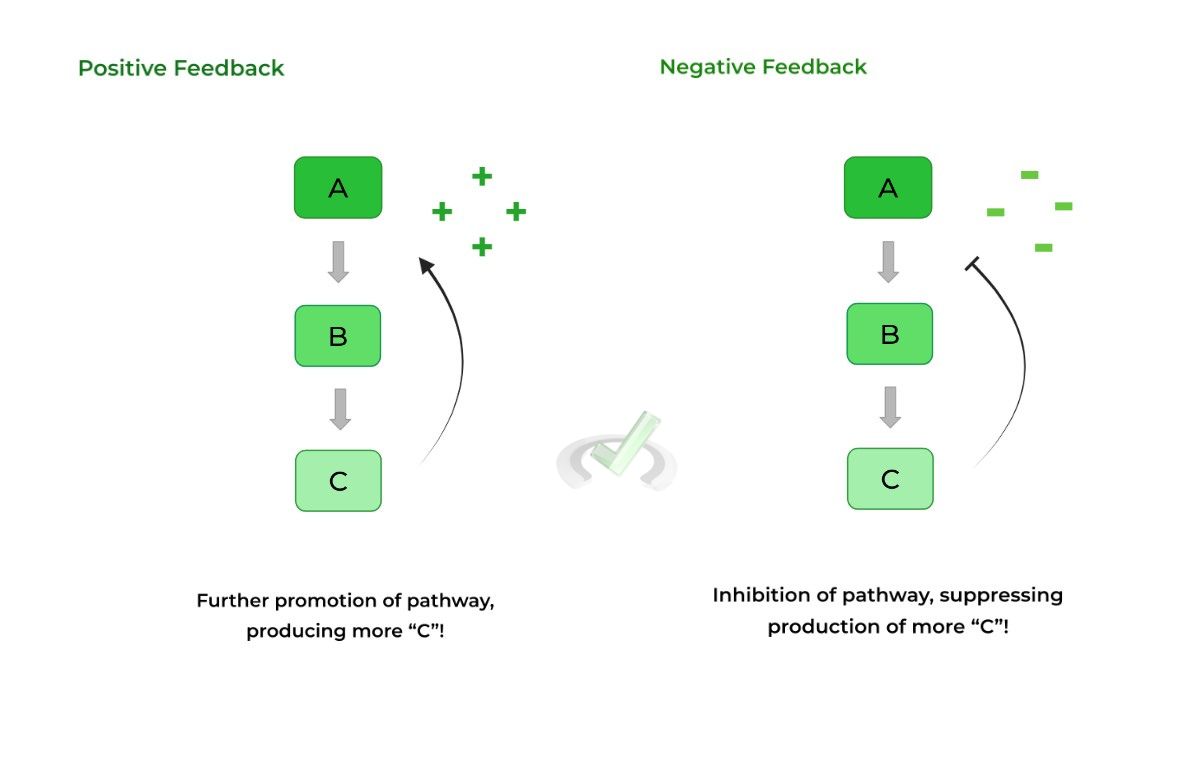
When dealing with the context of carbohydrate metabolism, we’ll really only need to focus on negative feedback pathways as these are the most common!
B. Allosteric Regulation of Metabolic Pathways
We’ll highlight 3 main downstream molecules that participate in the feedback, allosteric regulation of the enzymes in carbohydrate metabolism: 1) ATP/AMP, 2) citrate, and 3) NADH/NAD+.
We also want to point out that it’s not so important as to memorize which molecules activate/inhibit which enzymes, but more so to develop the logic and reasoning to why they activate or inhibit a certain enzyme!I. ATP/AMP
This should be the most obvious as this is the main indicator of cell energy sufficiency. 2 of the main targets for ATP/AMP are 1) phosphofructokinase-1 and 2) isocitrate dehydrogenase, as they are rate limiting enzymes!
Recall the functions and pathways of the enzymes: ultimately the goal for the enzymes is to produce energy for the cell in the form of ATP.
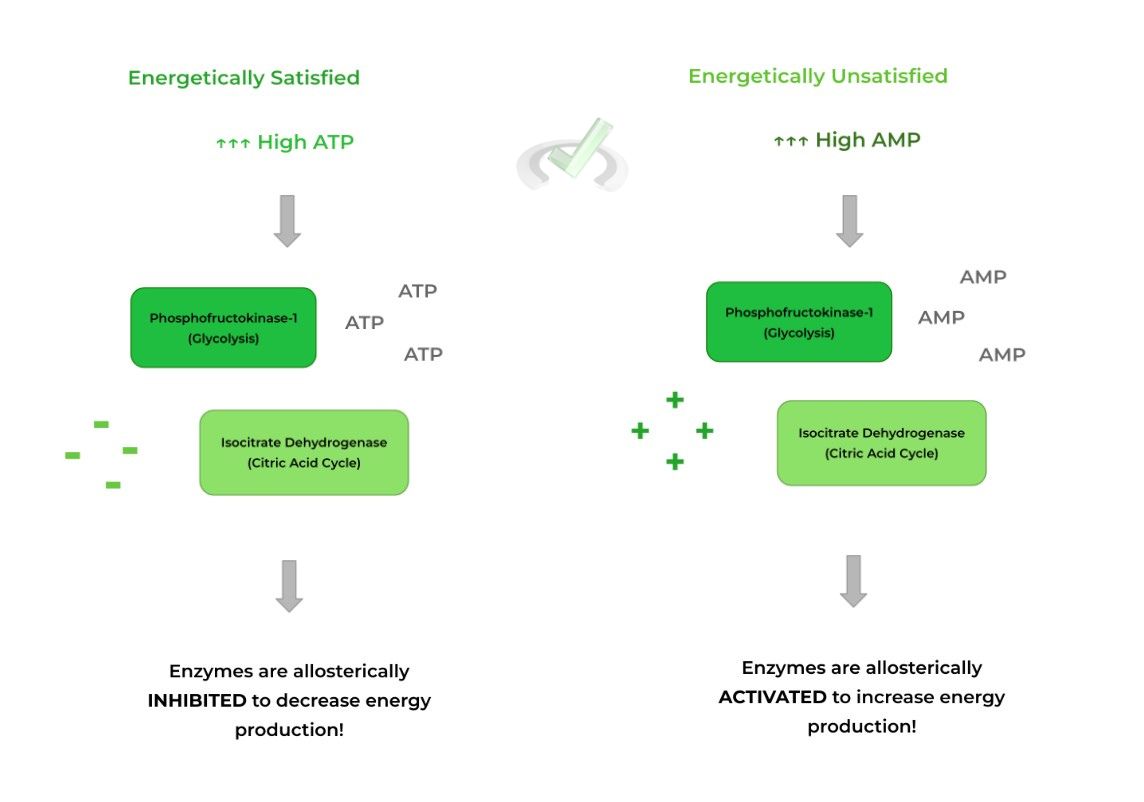
If cellular ATP levels are high (and AMP is low), the cell is energetically satisfied, and needs to allosterically INHIBIT the enzymes involved in energy production (PFK-1 & isocitrate dehydrogenase).
Here, the excess ATP “feeds back” to allosterically INHIBIT PFK-1 and isocitrate dehydrogenase!
However, if ATP levels are low (and AMP is high), then the cell is not energetically satisfied and needs to allosterically ACTIVATE PFK-1 and isocitrate dehydrogenase so energy production can increase!
In this case, the excess AMP feedback to allosterically ACTIVATE PFK-1 and isocitrate dehydrogenase!II. Citrate
Recall citrate as being an important substrate in the citric acid cycle! Most notably, citrate can feedback and allosterically regulate the PFK-1 again as well as citrate synthase. The logic similarly follows the rationale for ATP!
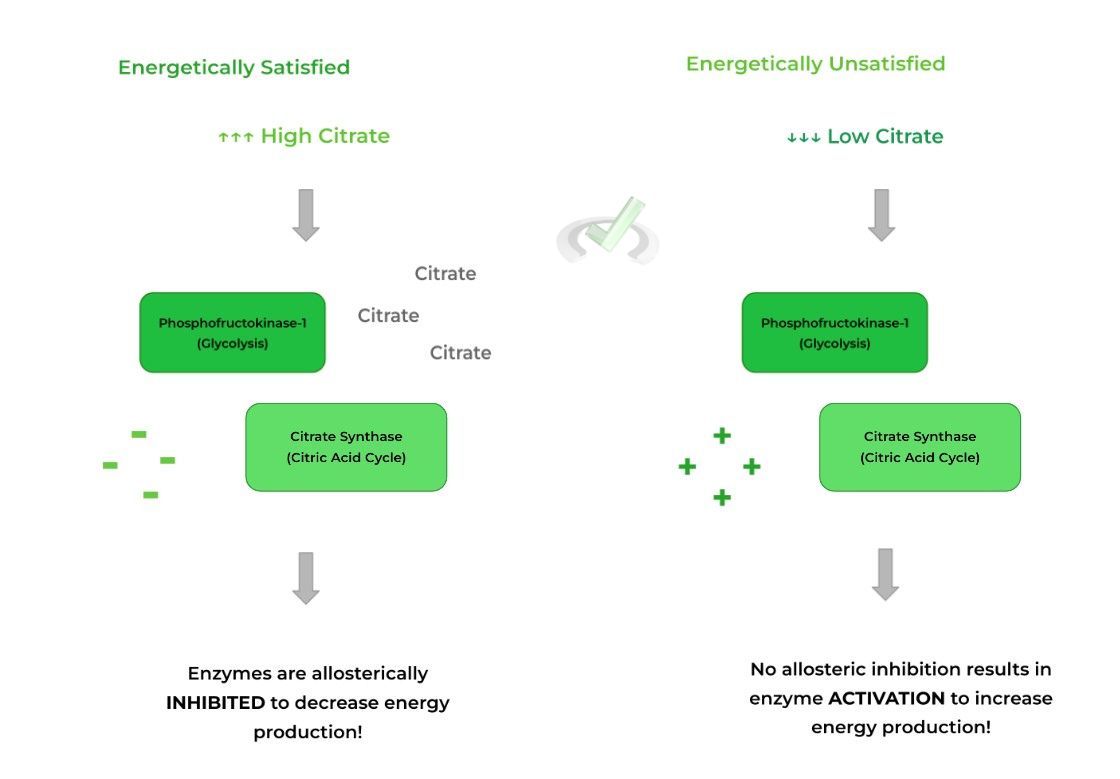
If citrate levels are high, much ATP is being produced and the cell is energetically satisfied! The excess citrate “feeds back” to PFK-1 and citrate synthase to INHIBIT them, decreasing ATP production!
If citrate levels are low, the cell needs to increase ATP production to satisfy energy needs! In this case, the lack of excess citrate prevents citrate from feeding back and allosterically inhibiting the enzymes, indirectly resulting in ACTIVATION!III. NADH, NAD+
It makes sense that these are also allosteric regulators as they are involved in many reaction within carbohydrate metabolism, particularly the citric acid cycle and mostly targeting citrate synthase, isocitrate and 𝛼-ketoglutarate dehydrogenase!
In fact, it is in the citric acid cycle where these molecules enact their regulatory actions! Make important note that in this case, NADH is the product!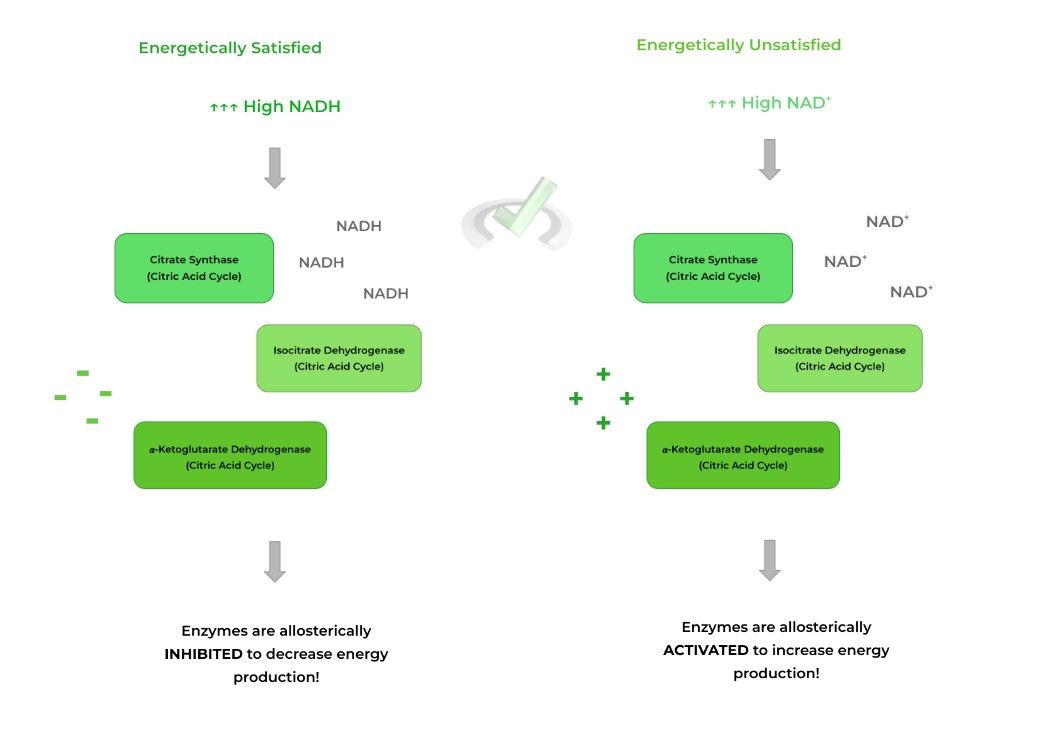
When NADH levels are high (and NAD+ are low), the cell again is energetically satisfied and the excess NADH feeds back and allosterically INHIBITS the above-mentioned enzymes.
When NADH levels are low (and NAD+ are high), the cell is in need of energy production, resulting in the excess NAD+ feeding back and allosterically ACTIVATING the enzymes.
Did you notice the term “excess” throughout our description? This is an important concept because a surplus of the molecule is needed to feed back to the pathway!
C. Hormonal Regulation of Fuel Metabolism
This is where a little memorization will come in handy! While there are a lot of hormones we can talk about, we’ll also limit our discussion to the main ones involved in carbohydrate metabolism: 1) insulin, 2) glucagon, and 3) cortisol.
I. Insulin
Recall that insulin is a peptide hormone that promotes a DECREASE of blood glucose through glucose uptake within the cell!
As such, it makes sense that insulin promotes glycolysis and glycogenesis as these processes take glucose into the cell and utilize it for energy production or storage.
Recall that the rate limiting enzymes for glycolysis and glycogenesis are PFK-1 and glycogen synthase, respectively, which are both promoted via insulin!
It’s also important to think about what insulin would inhibit: because we want blood glucose to decrease, processes that promote the entrance of glucose in the bloodstream such as gluconeogenesis, should be inhibited!
Furthermore, fructose-1,6-bisphosphatase is the main inhibition target of insulin as it’s the rate limiting enzyme of gluconeogenesis.II. Glucagon
Luckily, if you know the function of insulin, remembering the effect of glucagon is easy because it’s the exact opposite: working to INCREASE blood glucose!
Similarly, you just have to remember that glucagon will ACTIVATE the processes & enzymes insulin inhibits and INHIBITS all the pathways & enzymes insulin activates!
In this case, glucagon will activate fructose-1,6-bisphosphatase and glycogen phosphorylase, promoting gluconeogenesis & glycogenolysis in the liver; conversely, it’ll inhibit PFK-1 and glycogen synthesis, suppressing glycolysis and glycogenesis.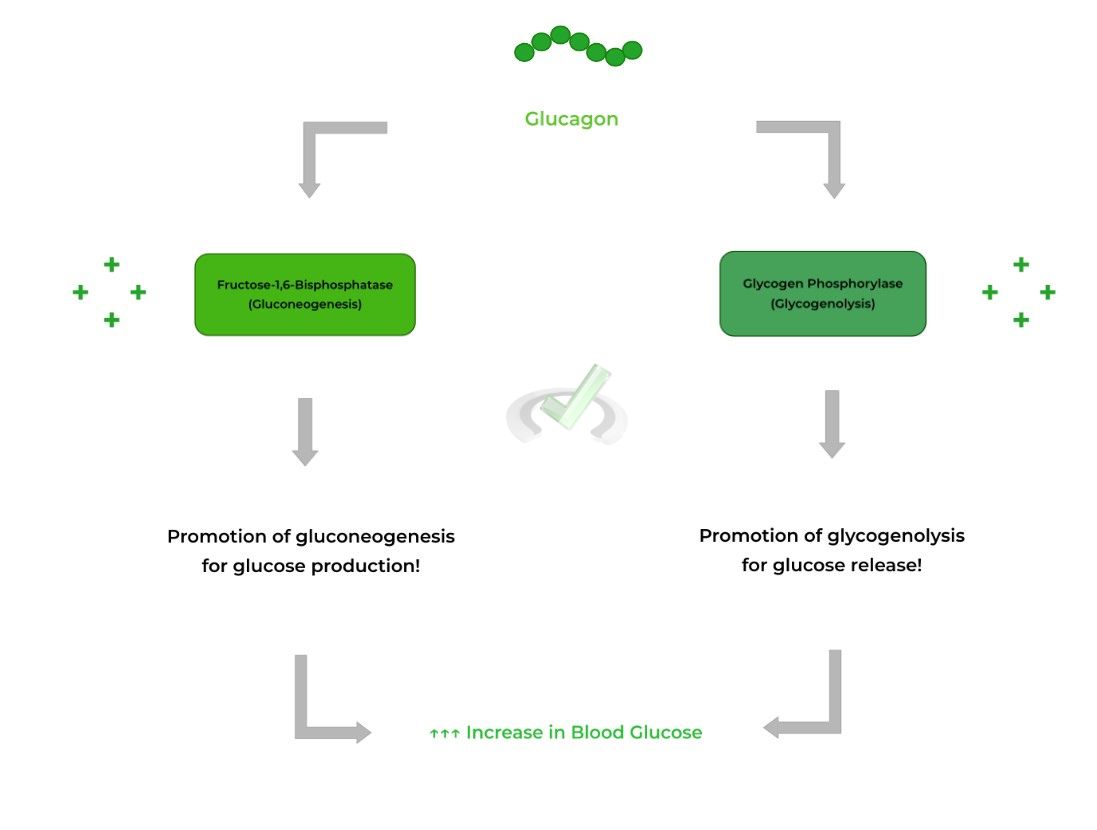
III. Epinephrine
Recall that epinephrine, one of the stress hormones, results in a similar effect to glucagon as it works to INCREASE blood glucose by promoting gluconeogenesis and glycogenolysis, thus activating fructose-1,6-bisphosphatase and glycogen phosphorylase!
It also helps to understand the physiological reasoning behind this: during states of stress, the body’s cells need more energy to accommodate the cellular processes in response to stress.
In this case, the increased blood glucose from gluconeogenesis and glycogenolysis stimulated by epinephrine becomes this source of energy!
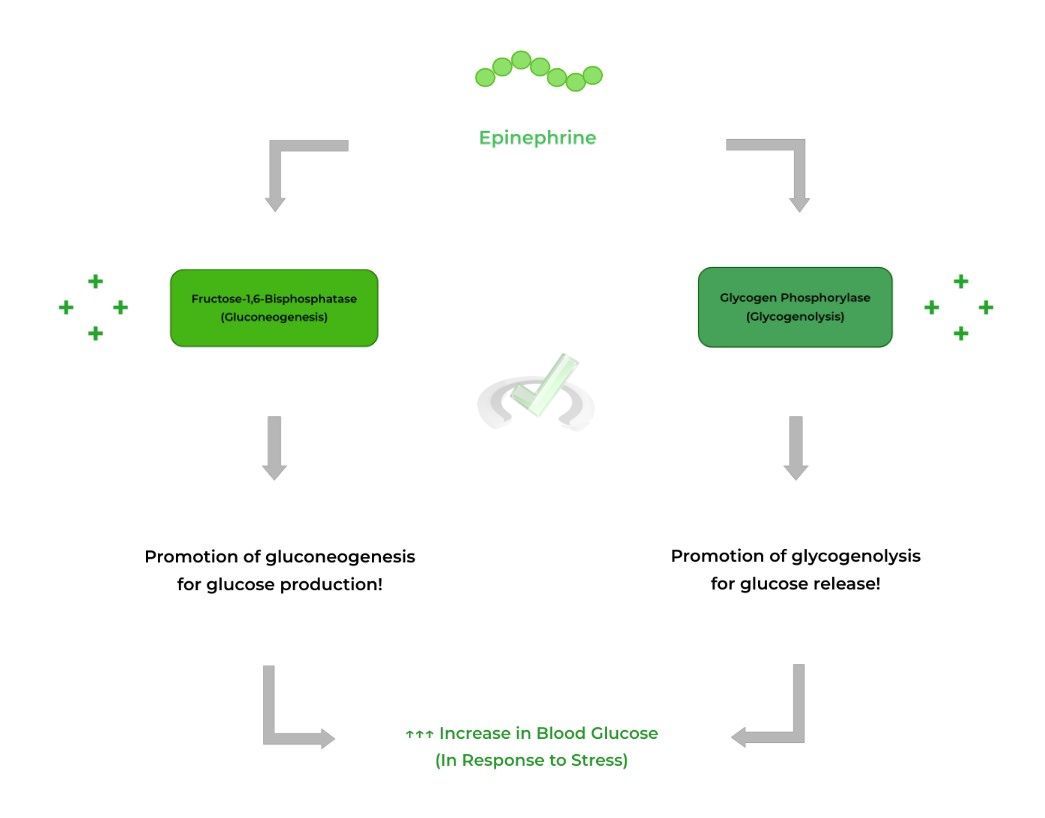
III. Bridge/Overlap
We established that when ATP levels are high (AMP levels are low), that the cell is energetically satisfied! But why is ATP a great indicator of cellular energy sufficiency? This all comes back to its use as the primary energy source of the cell, as we’ll recap right now!
I. ATP Structure and Function
It’s well known that ATP is the primary energy source utilized by the cell, but why is that? It all comes down to the structure, specifically the 3 phosphate groups attached on the molecule:
The adenosine triphosphate (ATP) molecule is arranged where the 3 phosphate groups are attached to the sugar. The 3 phosphate groups are termed alpha (𝛼), beta (𝛽), and gamma (𝛾), going from the inner to the outermost phosphate respectively.
There’s a high amount of stored energy between the phosphate groups due to the repulsive, electrostatic forces as the phosphate groups are negatively charged. Thus, the hydrolysis of the phosphodiester group releases a large amount of energy!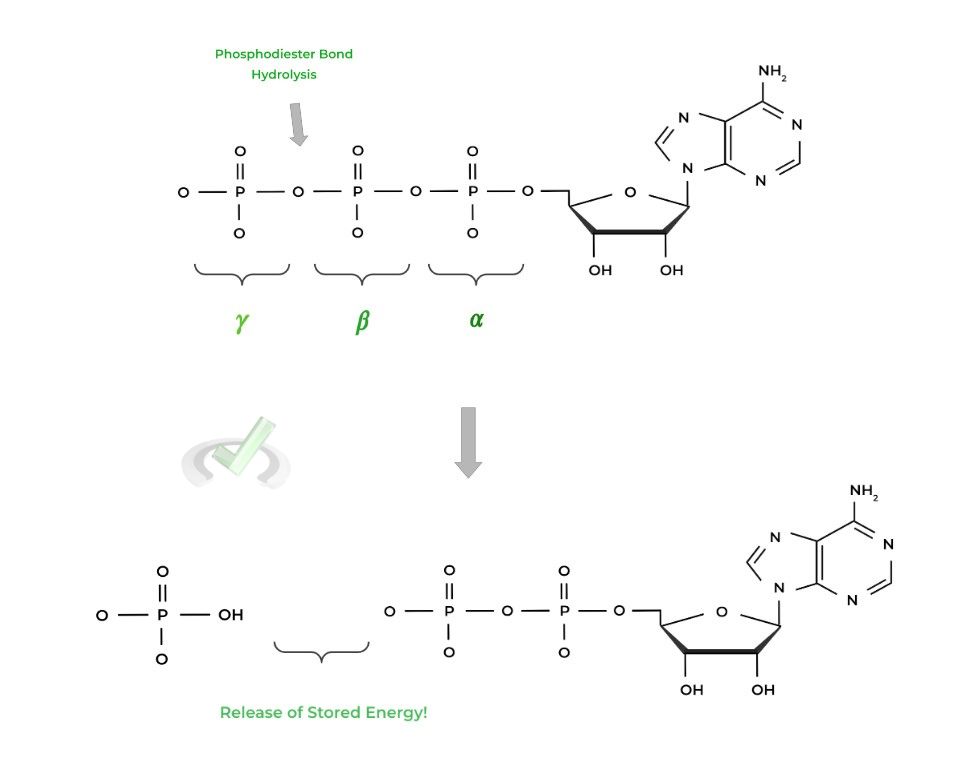
IV. Wrap Up/Key Terms
Let’s take this time to wrap up & concisely summarize what we covered above in the article!
A. Feedback Pathways
Biological and biochemical pathways where a downstream product/effect and “feedback” into an earlier step and either cause further promotion or inhibition of that pathway.
A promoting effect is termed positive feedback while an inhibiting effect is termed negative feedback. In the context of carbohydrate metabolism, pathways often participate in negative feedback!B. Allosteric Regulation of Metabolic Pathways
Though many molecules involved in carbohydrate metabolism are involved in allosteric regulation, the main ones include: 1) ATP/AMP, 2) citrate, and 3) NADH/NAD+.
It’s not so important that you memorize which molecule activates/inhibits a specific enzyme, but more so understanding the rationale as to why!I. ATP/AMP
This is the main indicator for cell energy sufficiency, primarily regulating PFK-1 and isocitrate dehydrogenase.
High ATP (low AMP) indicates the cell is energetically satisfied, resulting in the excess ATP feeding back and allosterically inhibiting the above mentioned enzymes.
Low ATP (high AMP) indicates the cell is not energetically satisfied, resulting in the excess AMP feeding back and allosterically activating the enzymes.II. Citrate
Recall that this is an important substrate in the citric acid cycle and will primarily also regulate PFK-1 and citrate synthase.
High citrate levels indicate the cell is energetically satisfied, resulting in the excess citrate feeding back and allosterically inhibiting PFK-1 and citrate synthase!
Low citrate levels indicate the cell is not energetically satisfied. Because there is no excess citrate to cause allosteric inhibition, the enzymes are indirectly activated!III. NADH/NAD+
Because they’re involved in many reactions in carbohydrate metabolism, they also function as allosteric regulators, primarily regulation citrate synthase, isocitrate and 𝛼-ketoglutarate dehydrogenase!
High NADH (low NAD+) indicates the cell is again energetically satisfied, resulting in the excess NADH feeding back and allosterically inhibiting the enzymes.
Low NADH (high NAD+) indicates the cell is not energetically satisfied, resulting in the excess NAD+ feeding back and allosterically activating the enzymes!C. Hormonal Regulation of Fuel Metabolism
Many of the carbohydrate metabolic pathways can also be regulated by the function of hormones, which is where a little memorization comes into play!
I. Insulin
Recall that the function of insulin is to DECREASE blood glucose: as such, processes such as glycolysis and glycogenesis, which promote glucose uptake to be used for energy or storage, should be promoted!
Likewise, the main rate limiting enzymes of these processes, PFK-1 and glycogen synthase, are stimulated and promoted by insulin!
Additionally, processes which increase blood glucose should be inhibited, such as gluconeogenesis. As such, its rate limiting enzyme, fructose-1,6-bisphosphatase, is also inhibited.II. Glucagon
Recall this hormone as antagonizing the function of insulin, promoting an INCREASE in blood glucose! In this case, processes such as gluconeogenesis and glycogenolysis, which promote the release of glucose, should be promoted!
As such, the rate limiting enzymes fructose-1,6-bisphosphatase and glycogen phosphorylase should be activated via glucagon!
Additionally, processes which promote a decrease in blood glucose (glycolysis and glycogenesis) are inhibited. Note that these are the processes that insulin looks to promote!III. Epinephrine
Think of epinephrine as having a very similar function to glucagon, working to INCREASE blood glucose, more specifically in times of stress.
Similarly, processes such as gluconeogenesis and glycogenolysis are promoted by this hormone within the liver, as well as their rate-limiting enzymes!
It helps to understand the physiological rationale for epinephrine induced increase in blood glucose! Increased blood glucose will be used as a source of energy to power the cellular process to accommodate the stress response.
V. Practice
Take a look at these practice questions to see and solidify your understanding!
Sample Practice Question 1
Which of the following enzymes would be highly promoted and active after a meal of pancakes and syrup? (yum!)
A. Glycogen Phosphorylase
B. Glycogen Synthase
C. Fructose-1,6-Bisphosphatase
D. Debranching Enzyme
Ans. B
After a meal, our blood glucose would drastically increase meaning we would need to decrease blood glucose to maintain homeostasis. This is where the 𝛽-islets cells of the pancreas release insulin.
Because insulin promotes a decrease in blood glucose, processes which promote glucose uptake such as glycolysis and glycogenesis and their respective enzymes are stimulated!
Sample Practice Question 2
Oftentimes when you see a lion or snake coming towards you, your sympathetic nervous system becomes stimulated. As such, which of the following enzymes would be most likely activated in the liver during sympathetic nervous system stimulation?
A. Fructose-1,6-Bisphosphatase
B. Glycogen Synthase
C. PFK-1
D. Branching Enzyme
Ans. A
Recall that in sympathetic nervous system stimulation, as stress response is induced resulting in the release of epinephrine. Also recall that epinephrine functions similar to glucagon, resulting in an increase of blood glucose
As such, processes which promote and increase in blood glucose, such as gluconeogenesis and glycogenolysis, will also be stimulated!



 To help you achieve your goal MCAT score, we take turns hosting these
To help you achieve your goal MCAT score, we take turns hosting these 
























